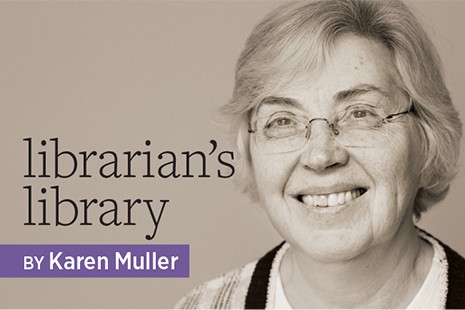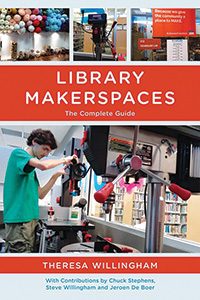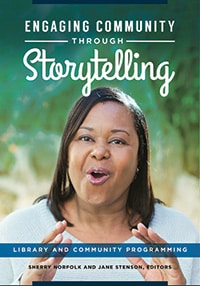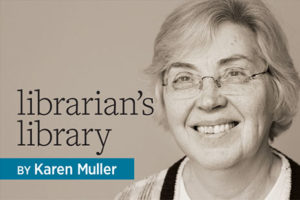
Bestselling author Jenn McKinlay often sets stories in her Library Lover’s Mysteries series during “crafternoons,” weekly library potluck luncheons that combine crafting and book discussion. It sounds like a wonderful programming idea—though as someone who participates in both knitting and book-discussion groups, I’m not sure about the weekly part. But McKinlay’s concept reveals much about the perception of the library as a community center. Here are several titles to help expand or reimagine programming, mostly in public libraries.
 Why libraries must expand their community role is explained in Transform and Thrive: Ideas to Invigorate Your Library and Your Community, by Dorothy Stoltz with Gail Griffith, James Kelly, Muffie Smith, and Lynn Wheeler. The authors explain how to build a culture in which risk-taking is encouraged and “unlearning” is developed to spur innovation. They stress the importance of listening to the needs and desires of a community as the first step toward building engagement, goodwill, and respect. They do not abandon the traditional focus on collections, however. Instead they explore ways to capitalize on the library’s role as a treasured cultural resource by using the collections as a springboard for creative programming. The appendices provide sample programming statements, evaluation forms, and checklists. ALA Editions, 2018. 168 P. $60. PBK. 978-0-8389-1622-3.
Why libraries must expand their community role is explained in Transform and Thrive: Ideas to Invigorate Your Library and Your Community, by Dorothy Stoltz with Gail Griffith, James Kelly, Muffie Smith, and Lynn Wheeler. The authors explain how to build a culture in which risk-taking is encouraged and “unlearning” is developed to spur innovation. They stress the importance of listening to the needs and desires of a community as the first step toward building engagement, goodwill, and respect. They do not abandon the traditional focus on collections, however. Instead they explore ways to capitalize on the library’s role as a treasured cultural resource by using the collections as a springboard for creative programming. The appendices provide sample programming statements, evaluation forms, and checklists. ALA Editions, 2018. 168 P. $60. PBK. 978-0-8389-1622-3.
 In Get Your Community Moving: Physical Literacy Programs for All Ages, author Jenn Carson encourages programming that gets people active. She defines physical literacy as an awareness of one’s body and “the motivation, ability, confidence, and understanding to move the body throughout the life course,” and argues that this awareness contributes as much to developing a well-rounded person as other literacies do. The rest of the book offers ways to increase physical activity in library spaces, addressing legal, financial, and behavioral issues along the way. Program plans for specific activities are included, along with vignettes detailing the efforts of library leaders in this aspect of programming. ALA Editions, 2018. 224 P. $54.99. PBK. 978-0-8389-1725-1.
In Get Your Community Moving: Physical Literacy Programs for All Ages, author Jenn Carson encourages programming that gets people active. She defines physical literacy as an awareness of one’s body and “the motivation, ability, confidence, and understanding to move the body throughout the life course,” and argues that this awareness contributes as much to developing a well-rounded person as other literacies do. The rest of the book offers ways to increase physical activity in library spaces, addressing legal, financial, and behavioral issues along the way. Program plans for specific activities are included, along with vignettes detailing the efforts of library leaders in this aspect of programming. ALA Editions, 2018. 224 P. $54.99. PBK. 978-0-8389-1725-1.
 Retro culture, fandom, game nights, and trivia are all aspects of pop culture that can be woven into programming. In Pop Culture-Inspired Programs for Tweens, Teens, and Adults, authors Amy J. Alessio, Katie LaMantia, and Emily Vinci present a range of ideas assembled by decades, touching on everything from Barbie to reality television, with a wrap-up section on classic cars, Disney, and games in general. The final chapters offer marketing ideas, reminders about licensing, and planning tips. ALA Editions, 2018. 144 P. $49.99. PBK. 978-0-8389-1705-3.
Retro culture, fandom, game nights, and trivia are all aspects of pop culture that can be woven into programming. In Pop Culture-Inspired Programs for Tweens, Teens, and Adults, authors Amy J. Alessio, Katie LaMantia, and Emily Vinci present a range of ideas assembled by decades, touching on everything from Barbie to reality television, with a wrap-up section on classic cars, Disney, and games in general. The final chapters offer marketing ideas, reminders about licensing, and planning tips. ALA Editions, 2018. 144 P. $49.99. PBK. 978-0-8389-1705-3.
 Two recent books cover the basics of initiating hubs of community creation and learning. They are Library Makerspaces: The Complete Guide, by Theresa Willingham with contributions by Chuck Stephens, Steve Willingham, and Jeroen DeBoer, and Makerspaces: A Practical Guide for Librarians, second edition, by John J. Burke, revised by Ellyssa Kroski. Library Makerspaces takes a textbook approach that looks at the philosophy behind makerspaces, along with history and statistics. Both titles include recommendations on how to lay the groundwork for a makerspace, implement the plans, and administer the program. Rowman and Littlefield, 2017. 262 P. $88. PBK. 978-1-4422-7740-3; Rowman and Littlefield, 2018. 208 P. $64. PBK. 978-1-5381-0818-5. (Both available as ebooks.)
Two recent books cover the basics of initiating hubs of community creation and learning. They are Library Makerspaces: The Complete Guide, by Theresa Willingham with contributions by Chuck Stephens, Steve Willingham, and Jeroen DeBoer, and Makerspaces: A Practical Guide for Librarians, second edition, by John J. Burke, revised by Ellyssa Kroski. Library Makerspaces takes a textbook approach that looks at the philosophy behind makerspaces, along with history and statistics. Both titles include recommendations on how to lay the groundwork for a makerspace, implement the plans, and administer the program. Rowman and Littlefield, 2017. 262 P. $88. PBK. 978-1-4422-7740-3; Rowman and Littlefield, 2018. 208 P. $64. PBK. 978-1-5381-0818-5. (Both available as ebooks.)
 These two new books address specific aspects of storytelling. Sherry Norfolk and Lyn Ford edited the essays in Storytelling Strategies for Reaching and Teaching Children with Special Needs and contributed thoughts on why storytelling is an effective learning mechanism, using its principles to suggest ways to meet the learning needs of different populations. Throughout, success stories from a wide variety of educators, teachers, storytellers, puppeteers, and librarians specify ways to adapt a story. Norfolk also edited Engaging Community through Storytelling: Library and Community Programming, this time with Jane Stenson. In this volume, the authors show how storytelling can aid in intercultural understanding and building cultural pride. Storytelling can be a way to learn from elders or hear the voices of the disenfranchised. As such, it builds community and enhances the role of the library. Libraries Unlimited, 2017. 218 P. $50. PBK. 978-1-4408-5364-7; Libraries Unlimited, 2017. 170 P. $50. PBK. 978-1-4408-5069-1. (Both available as ebooks.)
These two new books address specific aspects of storytelling. Sherry Norfolk and Lyn Ford edited the essays in Storytelling Strategies for Reaching and Teaching Children with Special Needs and contributed thoughts on why storytelling is an effective learning mechanism, using its principles to suggest ways to meet the learning needs of different populations. Throughout, success stories from a wide variety of educators, teachers, storytellers, puppeteers, and librarians specify ways to adapt a story. Norfolk also edited Engaging Community through Storytelling: Library and Community Programming, this time with Jane Stenson. In this volume, the authors show how storytelling can aid in intercultural understanding and building cultural pride. Storytelling can be a way to learn from elders or hear the voices of the disenfranchised. As such, it builds community and enhances the role of the library. Libraries Unlimited, 2017. 218 P. $50. PBK. 978-1-4408-5364-7; Libraries Unlimited, 2017. 170 P. $50. PBK. 978-1-4408-5069-1. (Both available as ebooks.)
 We end with a form of collections-based service. Libraries have been adding various forms of audiovisual media to collections for decades, starting in the 1920s with audio recordings. More recently, libraries are offering many other kinds of collections. Audio Recorders to Zucchini Seeds: Building a Library of Things, edited by Mark Robison and Lindley Shedd, explores the library’s role in the growing sharing economy. Why own a chain saw when you can borrow one from the library? Or a sewing machine? Or a guitar? In addition to reporting on specific collections, the editors provide guidance on cataloging, circulating, and maintaining items, and administering these unique programs. Much of the volume comprises case studies for a range of collections, with management tips specific to each. Libraries Unlimited, 2017. 271 P. $65. PBK. 978-1-4408-5019-6. (Also available as an ebook.)
We end with a form of collections-based service. Libraries have been adding various forms of audiovisual media to collections for decades, starting in the 1920s with audio recordings. More recently, libraries are offering many other kinds of collections. Audio Recorders to Zucchini Seeds: Building a Library of Things, edited by Mark Robison and Lindley Shedd, explores the library’s role in the growing sharing economy. Why own a chain saw when you can borrow one from the library? Or a sewing machine? Or a guitar? In addition to reporting on specific collections, the editors provide guidance on cataloging, circulating, and maintaining items, and administering these unique programs. Much of the volume comprises case studies for a range of collections, with management tips specific to each. Libraries Unlimited, 2017. 271 P. $65. PBK. 978-1-4408-5019-6. (Also available as an ebook.)


